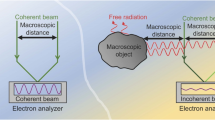Summary
Although the second-order coherence properties of a wide variety of optical fields have been investigated, the second-order coherence properties of fermion sources have been largely unexplored. In view of recent experimental proposals for novel extensions to fermionic systems of Hanbury Brown-Twiss-type experiments, it is important to understand better the coherence properties of fermion sources. In this paper a detailed study of the second-order temporal and spatial coherence of thermal electrons is made. Important distinctions between the coherence properties of thermal electrons and black-body radiation are pointed out. These distinctions arise from three principal considerations:a) particle number conservation,b) tensorial character of the basic fields,c) quantum statistics.
Riassunto
Sebbene siano state studiate le proprietà di coerenza di secondo ordine di una grande varietà di campi ottici, le proprietà di coerenza di second’ordine delle sorgenti fermioniche sono state poco esaminate. In vista delle recenti proposte sperimentali per nuove estensioni ai sistemi fermionici degli esperimenti del tipo di Hanbury Brown-Twiss, è importante capire meglio le proprictà di coerenza delle fonti fermioniche. In questo articolo, si fa uno studio dettagliato della coerenza temporale e spaziale di second’ordine degli elettroni termici. Si sottolineano importanti distinzioni tra le proprietà di coerenza degli elettroni termici e la radiazione di un corpo nero. Queste distinzioni sorgono da 3 considerazioni principali:a) conservazione del numero di particelle,b) carattere tensoriale dei campi di base,c) statistica quantistica.
Similar content being viewed by others
References
See, for example,Neutron Interferometry, edited byU. Bonse andH. Rauch (Clarendon Press, Oxford, 1979), for discussions of classic experiments in both neutron and electron interference.
D. Gabor:Light and information, inProgress in Optics, Vol.1, edited byE. Wolf (North-Holland. Amsterdam, 1961), p. 109.
The nonidentity between light and electron optics is manifested even at the level of first-order correlation phenomena by the Aharonov-Bohm effect, an interference phenomenon produced by the coupling of electric charge to electromagnetic potentials. Photons, therefore, cannot give rise to this effect. SeeY. Aharonov andD. Bohm:Phys. Rev.,115, 485 (1959).
M. P. Silverman:Nuovo Cimento D,97, 200 (1987).
R. Hanbury Brown andR. Q. Twiss:Philos. Mag.,45, 663 (1956).
R. Hanbury Brown andR. Q. Twiss:Nature (London),177, 27 (1956).
M. P. Silverman:Phys. Lett. A,120, 442 (1987).
M. P. Silverman:Phys. Lett. A,118, 155 (1986).
M. P. Silverman:Phys. Lett. A, (1987) in press.
S. Boffi andG. Caglioti:Nuovo Cimento B,3, 262 (1971).
Y. Ohnuki andT. Kashiwa:Prog. Theor. Phys.,60, 548 (1978).
E. Ledinegg andE. Schachinger:Phys. Rev. A,27, 2555 (1983).
See, for example,R. J. Glauber:Phys. Rev.,131, 2766 (1963).
A thermal-neutrino gas is perhaps a better fermionic analogue to black-body radiation, but one hardly conducive to experimental investigation. The neutrino counterpart to the Planck distribution for photons is described inP. J. Walsh andC. F. Gallo:Am. J. Phys.,48, 599 (1980).
R. C. Bourret:Nuovo Cimento,18, 347 (1960).
Y. Kano andE. Wolf:Proc. Phys. Soc.,80, 1273 (1962).
C. L. Mehta andE. Wolf:Phys. Rev. 134, A 1143 (1964).
C. L. Mehta andE. Wolf:Phys. Rev. 134, A 1149 (1964).
L. D. Landau andE. M. Lifshitz:Statistical Physics (Pergamon Press, London, 1958), p. 157.
The conversion to an infinite series is affected by setting 1/(exp [x]+1)=1−1/(1+exp [−x]), expanding\(1/(1 + \exp [ - x]) = \sum\limits_{n = 0}^\infty {( - 1)^n x^n } \) and carrying out the integration overx.
A. Erdelyi, Editor:Higher Transcendental Functions (McGraw-Hill, New York, N. Y., 1953), p. 24.
A. Erdelyi, Editor:Higher Transcendental Functions (McGraw-Hill, New York, N. Y., 1953), p. 48.
The Bernoulli numbers are defined by\(z/(\exp [z] - 1) = \sum\limits_{n = 0}^\infty {B_n z^n /n!} \). SeeA. Erdelyi, Editor:Higher Transcendental Functions (McGraw-Hill, New York, N. Y., 1953), p. 35.
R. Hanbury Brown:The Intensity Interferometer (Taylor and Francis, London, 1974).
Photon bunching is not a general property of photons, since radiation states can be constructed for which photons are uncorrelated or anticorrelated. It was demonstrated if ref. (4). that fermion ensembles characterized by a factorizable density operator (in a momentum-spin projection representation) generally manifest antibunching irrespective of the source coherence. There are, however, fermion ensembles comprised of certain highly correlated multifermion states that can exhibit other types of clustering behaviour, as reported inM. P. Silverman:Effects of potentials on fermion antibunching, Schrödinger Centenary Conference (Imperial College, London, 1987) andTheoretical study of electron antibunching in a field-emission beam, Meeting of the American Physical Society, Arlington Va, (1987).
Author information
Authors and Affiliations
Additional information
Traduzione a cura della Redazione.
Rights and permissions
About this article
Cite this article
Silverman, M.P. Second-order temporal and spatial coherence of thermal electrons. Nuovo Cim B 99, 227–245 (1987). https://doi.org/10.1007/BF02726584
Received:
Published:
Issue Date:
DOI: https://doi.org/10.1007/BF02726584



